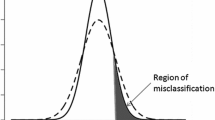Abstract
Using scores of 1200 students on a long test as a criterion, each of five subtests of different difficulty has maximum correlation with the criterion when the criterion is dichotomized at a value appropriate to the difficulty of the subtest. A 50-item test element is scored on an all-or-none basis with different standards for passing, and the percentage of passes for successive points on the criterion variable is computed. The Constant Method is applied to this relationship. The limen thus computed is a measure of difficulty, the dispersion is a measure of average (or total) validity, and the slope of the curve is a measure of differential validity. The difficulty of a test element is thus directly related to the maximum differential validity.
Similar content being viewed by others
Author information
Authors and Affiliations
Rights and permissions
About this article
Cite this article
Richardson, M.W. The relation between the difficulty and the differential validity of a test. Psychometrika 1, 33–49 (1936). https://doi.org/10.1007/BF02288003
Issue Date:
DOI: https://doi.org/10.1007/BF02288003




